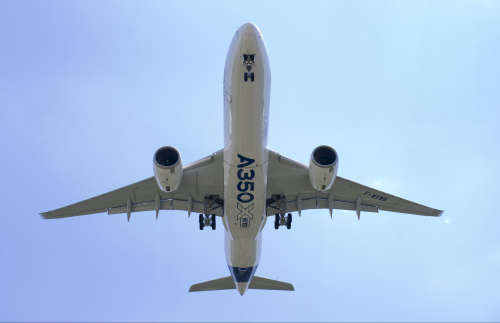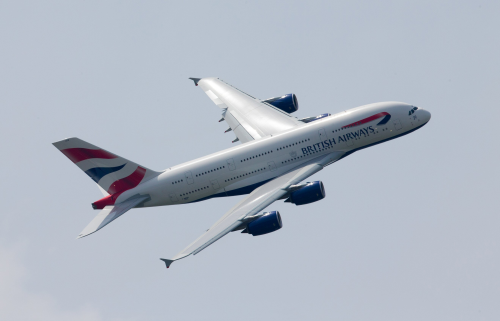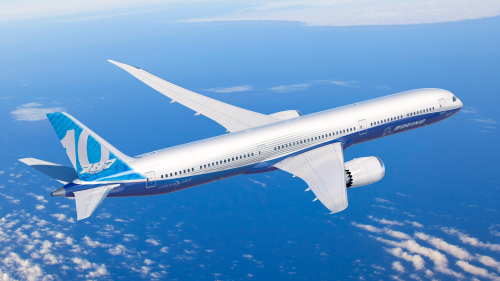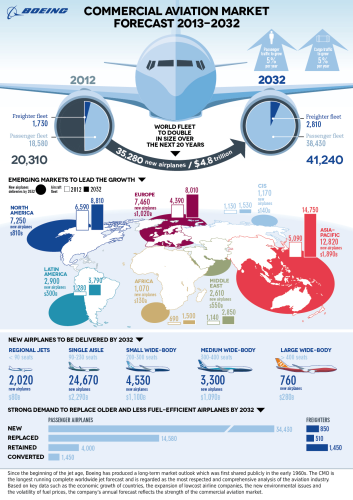



Highlights of the flying display on Day 7 of the 2013 Paris Air Show.
The first flight of a new aircraft model is always big news in the aviation industry, and for many the highlight of this year’s Paris Air Show was the long-awaited maiden flight of the A350 XWB, the first Airbus aircraft to be over 50 wt% composite.
A350 XWB 'MSN1' took off from Toulouse-Blagnac airport, France, on 14 June, the Friday before the start of the show. This first flight was followed by a second flight on Wednesday 19 June and a fly-by at Le Bourget on the Friday, the first public day of the show.
The first flight marks the beginning of a test campaign totalling around 2,500 flight hours with a fleet of five development aircraft. The flight testing will lead to the certification of the A350-900 (the middle model in the three-version family, seating 314 passengers in a three-class configuration) by the European EASA and US FAA airworthiness authorities.
The aircraft is scheduled to enter service in the second half of 2014 with launch customer Qatar Airways.
More fuel-efficient aircraft
The composites-intensive Airbus 380 and A350, as well as the Boeing 787 Dreamliner, are the vanguards of a new generation of aircraft which promise a range of improvements, including increased fuel efficiency and lower emissions, reduced operating costs, and enhanced passenger comfort. (See: Composites poised to transform airline economics – Part 1.)
Over 70% of the A350’s airframe is made from advanced materials that combine composites (53%), titanium and advanced aluminium alloys.
A key composites supplier to the A350 programme is Hexcel. The company's HexPly® M21E epoxy prepreg made with HexTow® IMA intermediate carbon fibre is used to manufacture the aircraft's fuselage panels, keel beam, the entire wing (covers, spars and centre wing box) and empennage. Hexcel's total material content on each A350 XWB aircraft is expected to be over $4 million. (See Hexcel's composites ready to fly on the A350 XWB.)
According to Airbus, the carbon fibre reinforced plastic fuselage results in lower fuel burn as well as easier maintenance. With this new fuselage – together with the latest systems and engines, and a wing optimised for Mach 0.85 cruise speed – Airbus claims that the A350-900 will offer a 25% lower fuel burn, 25% lower operating costs, and 25% lower CO2 emissions than its current competitor.
As of May, the A350 XWB had won 613 firm orders from 33 customers. At Le Bourget the aircraft gained 69 more orders and commitments worth US$21.4 billion from four customers.
The Airbus 'superjumbo' A380 also had a high profile at the show, with both static and flying displays. It also won an order for 20 aircraft from aircraft leasing company Doric Lease Corp in a deal worth more than $8 billion. Deliveries will begin in 2016.
The 23% composite A380 entered service in October 2007. The world’s largest commercial aircraft, the A380 has capacity to carry 525-853 passengers.
Boeing launches 787-10 Dreamliner
Airbus rival Boeing used the show to launch its 787-10 Dreamliner, the third and largest member of the 787 family. Composite materials make up 50% of the primary structure of the 787, including the fuselage and wing, and the aircraft is designed to use 20% less fuel than today's similarly sized airplanes. After entering service in 2011, the Dreamliner has had several technical problems (see FAA review for Boeing 787 – updated 16 January) but sales are still going well.
For the 787-10, which will have seating for 300-330 passengers, Boeing says it has commitments for 102 aircraft from five customers including Air Lease Corporation (30 aircraft), Singapore Airlines (30 aircraft) and United Airlines (20 aircraft).
Design of the 787-10 is already underway. Final assembly and flight test are set to begin in 2017, with first delivery targeted for 2018.
Meanwhile, the second member of the Boeing Dreamliner family, the 787-9, is in final assembly in Everett, Washington, USA, and is set to make its first flight in the second half of 2013. First delivery to launch customer Air New Zealand is set for early 2014. 20 customers have ordered 355 787-9s, accounting for 40% of all 787 orders.
Investing in composites
A number of other composites-related developments were announced at the show, including the following:
- Hexcel and Safran signed a contract for the supply of composite materials for the LEAP-1 engine programmes. The LEAP engine family is a product of CFM International, a 50/50 joint company between Snecma (Safran) and GE. Hexcel's HexTow® IM7 carbon fibre will be used to manufacture all LEAP-1 engine fan blades and containment cases, including the LEAP-1A selected for the Airbus A320neo, the LEAP-1B selected for the Boeing 737MAX, and the LEAP-1C selected for COMAC 919. Under the terms of the contract Hexcel will also supply Safran with HexPly® carbon fibre prepreg for the manufacture of the A320neo nacelles. (See: Paris Air Show 2013: Safran and Hexcel sign composite materials supply agreement for all LEAP-1 engines.)
- Cytec Industries also announced its selection as materials supplier for the LEAP engine programme. Cytec is planning to expand production capacities in Europe and the USA to support this. The LEAP-1 engine will utilise Cytec's CYCOM® PR520 RTM resin system in its fan blades and containment cases. (See: Paris Air Show 2013: Cytec selected as supplier for LEAP-1 engine.)
- GE Aviation announced the development of a composites facility at Hamble, UK, as part of a 5-year, US$50 million-plus investment at the site to support manufacture of wing components for the Airbus A350 XWB family. This will enable GE Aviation Hamble to ramp-up the output of wing fixed trailing edge components for the A350-800, A350-900 and A350-1000 aircraft, reaching the capacity to deliver up to 13 shipsets per month. The 9000 m2 facility is expected to start operations in early 2015. (See: Paris Air Show 2013: GE Aviation to build new composites facility at UK site to support A350 work.)
- TenCate Advanced Composites and Fokker Aerostructures signed an agreement under which TenCate will supply its thermoplastic composite materials to Fokker for the construction of aircraft components. The deal covers the supply of continuous fibre reinforced thermoplastic laminates and a range of semi-preg composite materials that are used in commercial, regional and military aircraft built by OEMs like Airbus, Boeing, Gulfstream, Dassault and AgustaWestland. (See: Paris Air Show 2013: TenCate and Fokker sign thermoplastic composites supply agreement.)
- The Dutch Minister of Economic Affairs, Henk Kamp, signed a letter of intent (LOI) for the proposed extension of the Thermoplastic Affordable Primary Aircraft Structure consortium (TAPAS), in which eight Dutch aviation companies and institutes have been working with Airbus on aerospace technologies since 2009. The LOI aims to extend the existing research agreement and focuses on the continuing development of thermoplastic composites for wing and tail applications, engine support structures, and fuselages. A fuselage panel for Airbus, made of thermoplastic composite from TenCate Advanced Composites, was also unveiled at the show. (See: Paris Air Show 2013: TAPAS partners and Airbus promote use of thermoplastic composites in aircraft.)
| Aircraft engines have traditionally been the domain of metal but aero engine manufacturers are now saving substantial weight by using composites in the fan blades and containment case. |
| For further information see: Aero engines lose weight thanks to composites. |
Aviation growth unabated
The commercial aviation market continues to grow. At the 2013 Paris Air Show, Airbus won US$68.7 billion worth of business for a total of 466 aircraft, while Boeing ended the show with customer announcements for 442 airplanes worth more than $66 billion.
Boeing projects a demand for more than 35,000 new aircraft over the next 20 years, valued at US$4.8 trillion. According to its Current Market Outlook (CMO) report, published annually, the world fleet will double over the next two decades (see: Boeing forecasts demand for more than 35,000 new aircraft over next 20 years). Both passenger traffic and cargo traffic are expected to grow 5% annually, fuelled in part by airlines replacing their older fleet with new, more fuel-efficient aircraft. Increased demand for aircraft that offer high efficiency, low operating costs, environmentally progressive technologies and an improved passenger experience look set to drive the continued adoption of composite materials.
As these figures demonstrate, demand for aircraft that offer high efficiency, low operating costs, environmentally progressive technologies and an improved passenger experience will continue to drive the use of composite materials.♦
Also see:
- Interview: Exelis Aerostructures gears up for growth This year Exelis Aerostructures attended the Paris Air Show as a standalone business. Reinforced Plastics asked Mike Blair, the business' new vice president and general manager, about his plans for growth.






